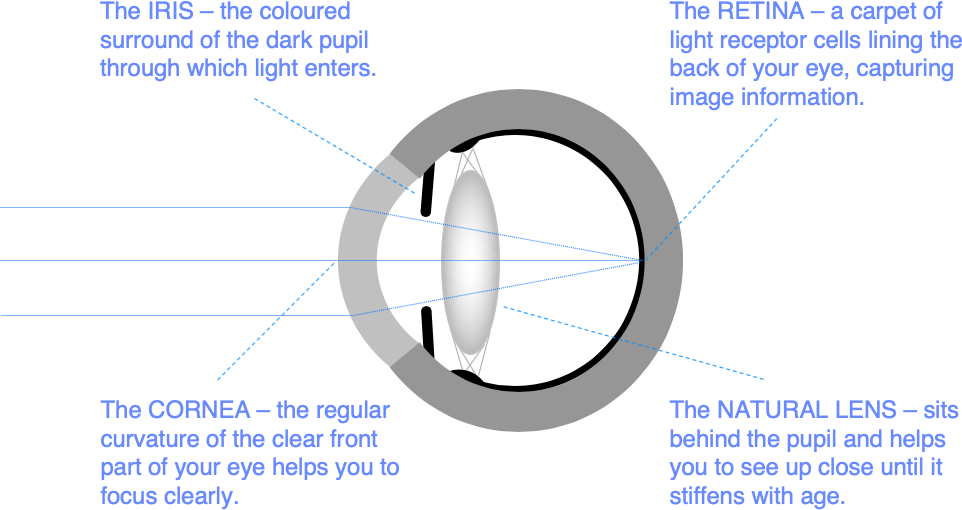You are here:
- Your Eyes / Astigmatism
Astigmatism
People with good eyesight are able to form a clear image of a distant object on the retina without any help from glasses or contact lenses. This is because the combined focusing power of the cornea and the lens is a good fit to the length of the eye, and because the curvature of the main focusing surfaces in the eye is regular – more football shaped than rugby ball shaped.

When the main focusing surfaces of the eye are more rugby ball shaped, you have astigmatism, and the amount of astigmatism is represented by the second number in your spectacle prescription for each eye.

Most of us have at least some astigmatism, and a small amount can even be helpful in extending the range of focus and the number of activities you can do without glasses later in life. But more than about 0.75 spectacle units (or dioptres) means that you are likely to prefer spectacles for most activities.
Astigmatism is corrected using rugby ball shaped (toric) lenses. Toric lenses have to be placed in the right axial orientation to neutralise your astigmatism effectively. Contact lenses work less well for astigmatism because they tend to rotate out of the optimum axial orientation. Toric lens implants are much more stable than contact lenses, and do not normally rotate out of position after implantation.
Vision correction surgery
Most people with hyperopia or myopia also have some astigmatism. Astigmatism can also be the main problem for your focus. Either way, once your prescription is stable, from the early 20s onwards, there are a range of good solutions.
We will be able to give you clear advice about which procedure would suit you best after tests at your preliminary consultation.
Here are some of the options:
-
Laser vision correction – modern laser systems are very effective at correcting astigmatism.
-
ICL implantation – people with higher levels of myopia and hyperopia also tend to have more astigmatism. Toric ICLs are a good solution for younger patients with higher prescriptions.
-
RLE (lens exchange) – toric multifocal lens implants can correct myopia, hyperopia, astigmatism, and the need for reading glasses.
You can find detailed information for each of these treatments on this site under Procedures.
Preparing for your consultation
If you are a soft contact lens wearer, you should leave your contact lenses out for 3 days before your consultation. Rigid contact lenses should be left out for 2 weeks. Contact lens wear can temporarily change the surface shape of your cornea. We ask you to leave your contact lenses out to help ensure that scan information we will use to guide your treatment is as accurate as possible.
You will normally be with us for 1-2 hours to allow time for scanning, refraction testing, eye health screening and procedure advice. There is usually some waiting between stages of the consultation, so bring something to read or to listen to.
We normally dilate your pupils to help examine the back of your eye. This can make driving more difficult for several hours afterwards. Parking is restricted in central London. So, we would recommend travelling to us using public transport or taxi.
The nearest tube station is OLD STREET (Northern Line).
Appointments and Enquiries
If you wish to arrange a preliminary consultation, please telephone Angelique Thomas on 020 7566 2156 or 07484 081815 (or from outside the UK +44 20 7566 2156 or +44 7484 081815) or email moorfields.ballan@nhs.net
